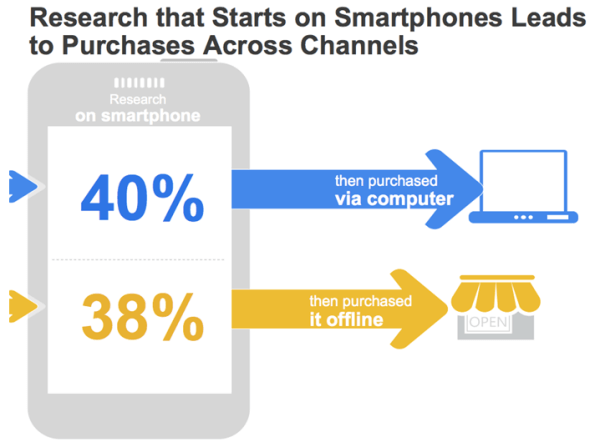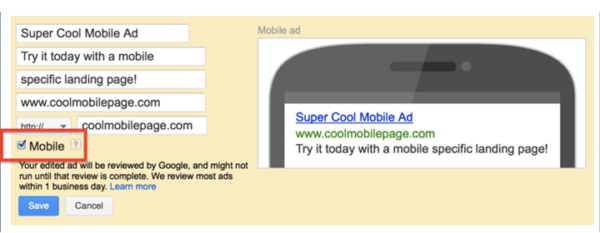Mobile PPC Tips & Tricks – What Works & Doesn’t
As we all know, the mobile environment is becoming more important, and mobile PPC is a topic companies are starting to pay more attention to. At this point, there’s still a lot of low-hanging fruit out there. In this article, I’ll share some mobile stats to begin with, and then provide some PPC tips and […]
As we all know, the mobile environment is becoming more important, and mobile PPC is a topic companies are starting to pay more attention to. At this point, there’s still a lot of low-hanging fruit out there.
In this article, I’ll share some mobile stats to begin with, and then provide some PPC tips and tricks we’ve learned along the way related to mobile ad copy, mobile landing pages and mobile scheduling strategies.
Mobile Growth
Mobile usage is on a pretty big upswing, and “the year of mobile” is coming much faster than people think. Are you losing sales today from bad mobile advertising/experiences? Maybe, maybe not, depending on your industry and competition. But will you lose sales down the road from bad mobile advertising/experiences? The answer is absolutely YES!
Marin Software recently released a study which projected that mobile would account for 50% of all paid search clicks on Google by the end of 2015. The study noted the rise of mobile click share over the course of 2013, from 21.8% in January to 34.2% in December. This means that, as of the end of last year, mobile accounted for just over one third of all paid search clicks on Google!
Still think you’re not missing out if your paid search program is not optimized for mobile?
Consider this, then: As of March last year, research showed that 73% of mobile searches triggered some sort of follow-up action, and 28% resulted in conversions. With mobile usage rising steadily year-over-year, we can reasonably expect that mobile PPC conversions will continue to rise as well. Advertisers who fail to capture this audience will soon be losing out big-time.
Mobile Context Information
It helps to understand how people are searching and what people are searching for on their phones. This information can help us to understand the overall context in which we’re advertising, allowing us to place ads accordingly. Here, I’ll discuss four basic mobile user behaviors. Mobile users are:
- Information Research. Consumers research information on their phones and are looking for information like directions to a store, phone numbers, restaurants, pubs, etc.
- Buying Products. Consumers buy on mobile devices. According to Bing research presented at SMX Advanced in June, mobile users are making inexpensive and often impulsive purchases — for example, housewares tend to convert well on mobile.
- “Multiscreening.” Consumers use multiple screens. Examples are using a phone (researching) while watching TV, using a phone while surfing the net, etc. There’s even been talk about the mobile screen becoming our primary screen by which we control all other screens.
- Searching Now & Buying Later. Numerous case studies show that many consumers initiate research on mobile devices, but will continue (and possibly end) their journey on a PC. A Google report from May 2013 stated that 77% of people have searched for a product or service on their phone, and many go on to convert via a different channel.
Mobile PPC Strategies
In this section of the article, I’ll cover four topics:
- Mobile Ad Copy
- Mobile Ad Extensions
- Mobile Landing Pages
- Mobile Scheduling Strategies
1. Mobile Ad Copy
First, when creating ads in AdWords, make sure you opt into mobile. As you know, you don’t have to have mobile preferred ads to display on mobile devices. With this, ads will be better optimized for different screens and users will have a better mobile user experience.
When creating your ads, include mobile-specific wording. You can highlight “mobile” in ad copy or in the URL name (or both), as shown below. This adds credibility to your business and communicates to searchers that they can expect a good mobile experience on your site. When we mention “mobile” in ads, it increases click-through rate as much as 2x (not a huge difference in CPA).
Highlight Immediacy. Speed and convenience are the main drivers of mobile search, so you want to respond to that with wording that conveys immediacy. Here are some examples:
- Buy now
- Shop now
- Call now
- Call today
- Ships now
- 24/7 customer support
- Etc.
Don’t Forget To Test. We’ve seen some serious increases from very simple wording changes. For example, when testing “call us” vs. “contact us,” we found that “call us” was the better option on mobile.
2. Mobile Ad Extensions
Several of the ad extension products are very useful when it comes to mobile. Here’s a brief rundown of some of the extension products we like.
- Sitelinks. We love highlighting “call us” and driving directions within mobile PPC sitelinks. They can be scheduled and specifically designated as mobile.
- Location Extensions. These make a huge difference in mobile ads. We’ve seen different results when we’ve shown location extensions when a store is open and when a store is closed. Make sure you test, as one could work better than the other.
- Call Extensions. In our testing, we’ve found that call extensions work very well in mobile ads. It best to schedule them for when you have people in the office answering the phone.
- Seller Ratings. If you’re eligible for seller ratings, be sure to include the most important copy at the beginning of your description lines so your ad copy is not truncated. (Note: seller ratings aggregate info from sources like sellerratings.com, bizrate.com, etc.)
3. Mobile Landing Pages
On the whole, companies large and small have done a poor job optimizing their mobile PPC landing pages — so there’s a lot of low hanging fruit here.
In our experience, mobile specific pages perform better than responsively designed pages. Mobile landing pages should:
- Be Brief & Legible. Do not have big chunks of text on the page, and ensure that the font size is large enough for people to read without having to zoom in.
- Load Quickly. Aim to have pages load in under 5 seconds. Unfortunately, any longer and visitors will likely be off your site and onto to a competitor’s site.
- Be Click-Friendly. Buttons should be clickable (remember, this is a human finger, not a mouse), and the copy on buttons should be easy to see without zooming.
- Have Simple Forms (if applicable). Forms should include no more than 3-4 fields and a clear “submit now” button. Include extra info like “learn more” and/or the option to download an app further down the page so the important info is clearly accessible/visible to the user.
- Have A Clear Call-To-Action. And know that the call-to-action could be a phone number, as well.
4. Mobile Scheduling Strategies
Time of day is important when it comes to mobile, so I want to cover this for a bit.
This is some Citi Investment research and analysis. It shows that mobile is more popular than desktops in the morning (before work) and after work (8 p.m). People are primarily searching on PCs during the day.
We’ve also found that people tend to purchase at the end of the day, and CPA decreases throughout the day. In the image below (from Bing), the red line is the mobile CPA line. You’ll notice it goes down throughout the day, with a couple of spikes at lunch and during the commute home when people are searching and not buying.
So, it’s important to not spend your entire budget at the beginning of the day. Make a point to schedule your budget to allow for good CPA clicks at the end of the day.
Attribution
Not only are clicks from other devices being undervalued, but some are not considering that people convert in other ways.
Attribution models were designed for one device. They tend to break when there’s more than one device involved — even more so when calls and offline purchases are involved. Understand that there will be a certain amount of messiness in measurement and you will not fully understand where conversions stem from.
Conclusion: 3 Takeaways
- You want to do better mobile
- Be better at driving people from mobile to store
- Be better at driving people from mobile to call
Contributing authors are invited to create content for Search Engine Land and are chosen for their expertise and contribution to the search community. Our contributors work under the oversight of the editorial staff and contributions are checked for quality and relevance to our readers. The opinions they express are their own.
Related stories
New on Search Engine Land





